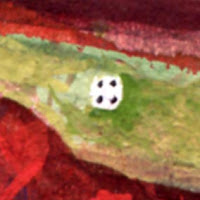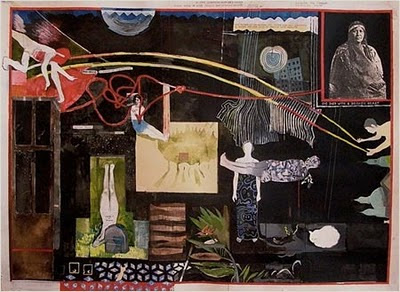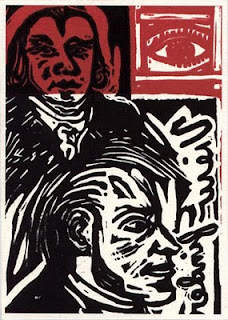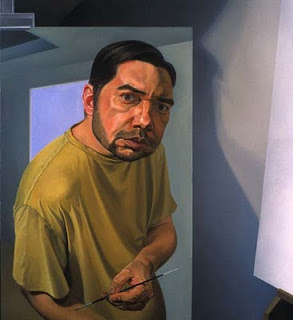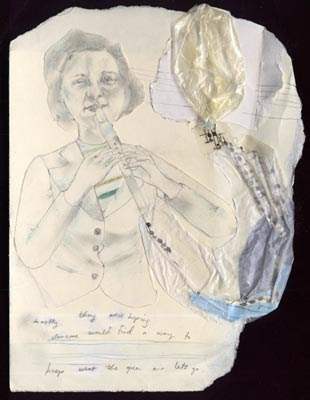Category: Viewfinder Project
Joshua Mosley’s Mirror, Mirror and Geoffrey Beadle’s Puzzler
(For more information about the “Viewfinder Project” click here.)
I met Joshua Mosley at an opening at the Fleisher Art Memorial in 2005. Since then, I have not seen him often but have kept in contact (Mosley is a Professor of Animation at the University of Pennsylvania). I sent him a request to contribute to the “Viewfinder Project” and received a prompt response and result. At first I didn’t know what to think because he had scanned and flipped the image I had made. I received a mirror image printed on the back of the “Viewfinder” card I had sent him. It felt as if he had sent the print back to stare at me in the way one looks at a mirror.
Overtime Mosley’s adaptation has grown on me. The colors from the inkjet printer used are a little softer and have settled in the paper in a way that my oil based ink did not. As far as I can tell, Mosley’s version was printed directly on the original paper I sent. This meaning that a bleed print would be near impossible (digital printers are not equipped to print over the edges of paper). Hence, he had made an image slightly smaller with a minimal border. These differences became unnoticeable once I scanned Mosley’s image and posted it below. Unless one wants to make an appointment to see the original, viewers will have to trust it’s authenticity. Perhaps being one step removed can reveal limitations similar to those found when one looks in the mirror? However, There are times when we have to trust even when we can’t fathom the reflection.
Originally I thought Geoff Beadle’s viewfinder involved mirrors but now I am not so sure. Geoff is a painter and professor at Edinboro University of Pennsylvania who makes revealing self portraits. He is aided by mirrors and sometimes uses mirrors coupled with a photographic views. These paintings are about intently and fearlessly observing even when the view is not always flattering. However, a mastery of materials and technique present a paradox where a grittier more complex conception of beauty is possible. I found his viewfinder compelling because it is literal like Mosley’s digital print yet it also is transformative. Try as I may, I am uncertain whether light is emanating from an object being framed or whether it is some how a reflection shining off the viewfinder being held. I get the feeling that Beadle is in the photograph and is illusively revealing another self portrait. Here he is directly revealing the the tricks of his trade, namely, through camera work, the viewfinder (like that being held), as well as through lighting and reflection.
Viewfinder Continued: A Collage By Katie Parry
Several of the artists involved in the “Viewfinder Project”, including Katie Parry, transformed the initial “Viewfinder” print in sculptural ways. Parry built outward glueing new materials to the back of the print. Below is a view of the print after Parry had worked on it.
Viewfinder And A Painting By Anda Dubinskis
One task that stands out in my mind from high school art class and later college drawing class was making a viewfinder. We were assigned to cut a square out of the center of a piece of matboard. Thus, making a device to help one compose pictures. By using this window to frame a view one can get a sense of what should fit in a drawing and what should be left out (students are suppose to consider the edges of their pictures and the use of positive and negative space to their advantage).
A New Press and A Hunter Finds Her Target
I finally had a chance to go to Philadelphia (December 18th) and to see some artwork and socialize. I visited Rebekah Templeton Gallery and then went to the grand opening of the Second State Press. Jackie Hoving’s exhibit Crypsis was on view at Rebekah Templeton. The exhibit featured two large collaged wall pieces, several smaller collage works (in both the gallery and the back room), and a video on a pint-sized screen. With regard to the large work, one collage referred to gaps in the content of the other. Below is one wall of the gallery and the following image shows the adjacent wall.
Jackie Hoving, Hunter in Forest, paper, spray paint, acrylic, ink, 2010, 108 x 224.25 inches
Jackie Hoving, Forest in Hunter, paper, spray paint, acrylic, ink, 2010, 108 x 175 inches
Hunting themes dominate Hoving’s work whereby she uses camouflage and references finding one’s target. I feel most art making involves hunting for images, content, meaning, or a look. However, the artist’s inspiration very rarely purposefully hides. Although art usually does not involve hunting for the kill, I still find art more illusive and for the most part more valuable than the hunters pelt. What is most compelling about this work is the effort to find a view amidst difficult circumstances whether that is about finding a target in a dense forest or about the ethical or cultural issues relating to a hunting culture. In a day and age when hunting is rarely a necessity for food and clothing, this exhibit shows how close hunting is related to ritual as well as to a fashion that is political, visual, and social. For more images and information visit the Rebekah Templeton website.
After leaving the gallery, I headed over to the Crane Arts Building to the opening of the Second State Press. This is a new nonprofit print center that allows artists to rent time in order to use the presses. The rates are rather modest if one has specific printing needs.

